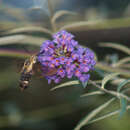fr
noms dans le fil d’Ariane


Sphinx colibri
Le Sphinx colibri (Hemaris thysbe) est une espèce nord-américaine de lépidoptères (papillons) de la famille des Sphingidae.
Son aire de répartition s'étend de l'Alaska et du sud des Territoires du Nord-Ouest jusqu'à la Colombie-Britannique et l'Oregon, à l'est dans les Grandes Plaines et la région des Grands Lacs dans le Maine et à Terre-Neuve ; au sud de la Floride et du Texas.
L'imago a une envergure de sept centimètres ; il est parfois confondu avec les colibris ou les abeilles en raison de ses ailes en mouvement rapide et de leur coloration. Cela vaut à l'espèce le nom français de « Sphinx colibri » (nom qui aussi employé en Europe pour désigner une autre espèce, Macroglossum stellatarum).
Les chenilles mangent viorne, aubépine, chèvrefeuille, et quelques espèces d'arbres fruitiers.
Sphinx colibri
Le Sphinx colibri (Hemaris thysbe) est une espèce nord-américaine de lépidoptères (papillons) de la famille des Sphingidae.